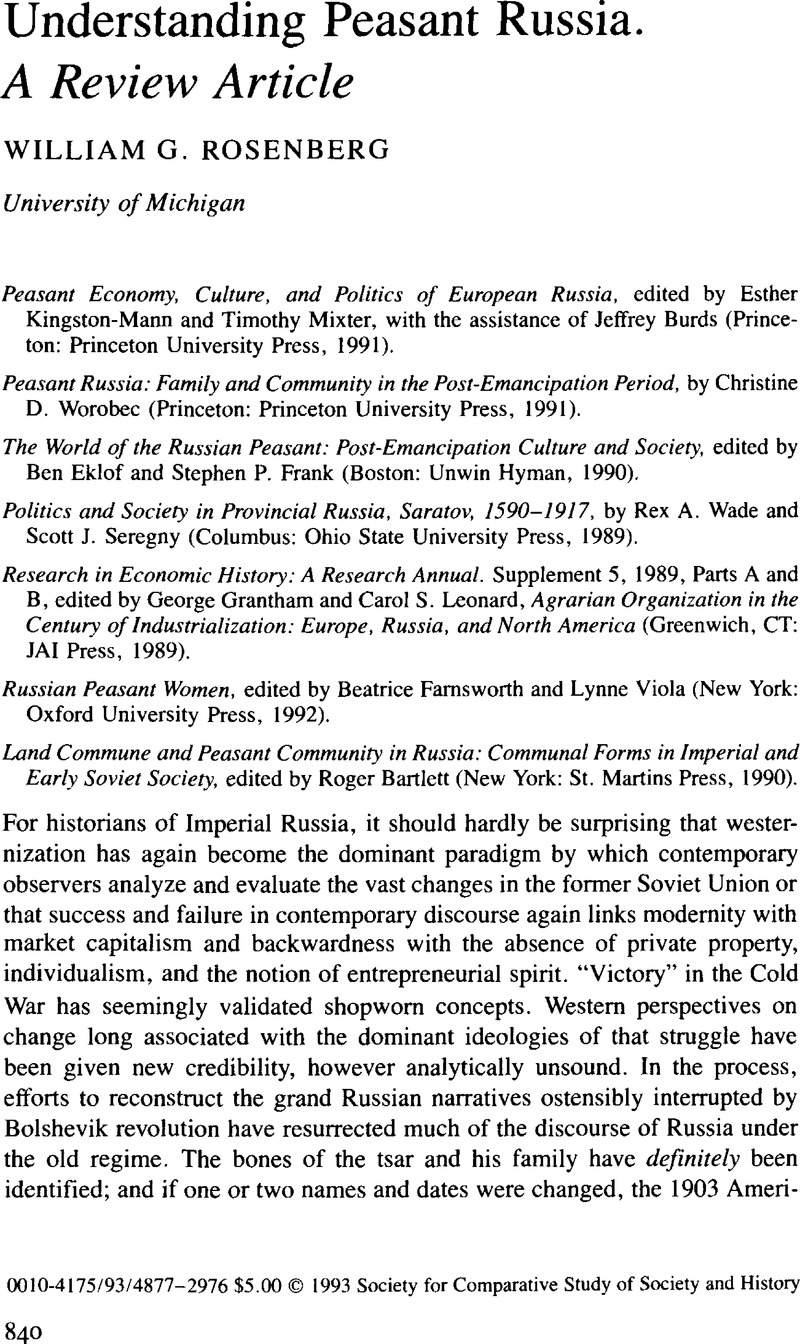Article contents
Understanding Peasant Russia. A Review Article
Published online by Cambridge University Press: 03 June 2009
Abstract

- Type
- CSSH Discussion
- Information
- Copyright
- Copyright © Society for the Comparative Study of Society and History 1993
References
1 Robinson, Geroid T., Rural Russia under the Old Regime (New York: Columbia University Press, 1932)Google Scholar; Gerschenkron, Alexander, Economic Backwardness in Historical Perspective (New York, 1964)Google Scholar; and “Agrarian Policies and Industrialization: Russia 1861–1917,” in vol. 6, pt. 2 of The Cambridge Economic History of Europe, 706–800 (Cambridge: Cambridge University Press, 1965)Google Scholar.
2 Shanin, Teodor, The Awkward Class: Political Sociology of Peasantry in a Developing Society:Russia, 1910–1925 (Oxford: Oxford University Press, 1972)Google Scholar.
3 Shanin, Teodor, Russia as a “Developing Society”, vol. 1, and Russia, 1905–1907: Revolution as a Moment of Truth, vol. 2, of The Roots of Otherness: Russia's Turn of Century (New Haven, 1985)Google Scholar.
4 Wolf, Eric R., Peasants (Englewood Cliffs, N.J.: Prentice Hall, 1966)Google Scholar. The phrase is his title for ch. 1.
5 See especially his “K voprosu o kharaktere agrarnogo stroia evropeiskoi Rossii v nachale XX v.,” Istoricheskie Zapiski, 65 (1959), 119–62Google Scholar.
6 See e.g., his “K voprosu o kharaktere i izuachenii krestianskoi pozemel’noi obshchiny v Rossii,” in Problemy sotsial’no-ekonomicheskoi istorii Rossii (Moscow, 1971)Google Scholar; Sovetskaia dokolkhoznaia derevnia, 2 vols., (Moscow, 1977, 1979)Google Scholar.
7 Anfimov and Danilov's views remain in particular a source of intense conflict, not only overtheir accuracy but about the integrity of recent Soviet historiography in general.
8 Shingarev, A. I., Vymiraiushchaia derevnia (St. Petersburg, 1907)Google Scholar.
9 Bideleux is critical in this respect of Gerschenkron, 's “Agrarian Policies and Industrialization: Russia, 1861–1917,” in vol. 6 of the Cambridge Economic History of Europe (Cambridge: Cambridge University Press, 1965)Google Scholar; Robinson's Rural Russia under the Old Regime; Pavlovsky, G., Agricultural Russia on the Eve of Revolution (London, 1930)Google Scholar; Confino, M., Systèmes agraires et progrès agricole: l’assolement triennal en Russie au XVIII–XIX siècles (Paris, 1969)Google Scholar; Robbins, R. G., Famine in Russia, 1891–1892 (New York, 1975)Google Scholar; Smith, R.E.F. and Christian, D., Bread and Salt: A Social and Economic History of Food and Drink in Russia (Cambridge, England, 1984)Google Scholar.
10 E.g., in Macey, David's otherwise excellent essay, “The Peasant Commune and the Stolypin Reforms: Peasant Attitudes, 1906–14,” in Bartlett, Land Commune, 221Google Scholar.
11 Hoch, Steven, Serfdom and Social Control in Russia: Petrovskoe, a Village in Tambov (Chicago, 1986)Google Scholar.
12 Christine Worobec, “Peasant Women and Patriarchy, ” in Kingston-Mann and Mixter, 206. See also the extended discussion in Peasant Russia, ch. 6.
13 Worobec, C., “Temptress or Virgin? The Precarious Sexual Position of Woman in Postemancipation Ukrainian Society,” Slavic Review, 49:2 (1990), 227–38CrossRefGoogle Scholar.
14 Eklof in Bartlett, Land Commune; and Eklof and Frank in Wade and Seregny, Politics and Society.
15 Johnson in Elkof and Frank, The World of the Russian Peasant.
16 Engel in Frank, The World of the Russian Peasant.
- 1
- Cited by




